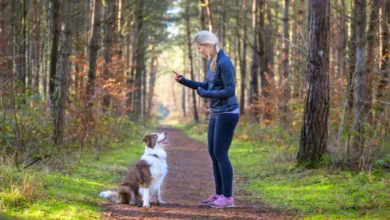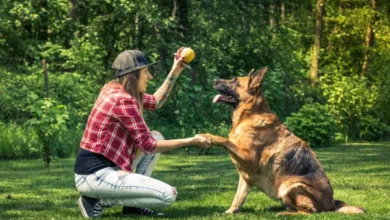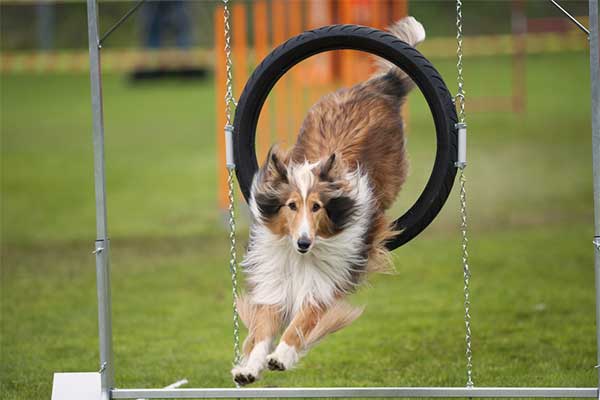
Unless you’re a professional dog trainer, you’ll be vexed by the same question that stumps all first-time dog parents—How do I train my dog to do tricks?
Training your dog is an extremely fun bonding experience and promotes their social skills and improves their obedience. Learning ‘how to’ is not hard or challenging. All you need is a treat your pet loves and a little patience.
No matter how young or old your dog, you can train them to master any trick with our expert guide!
Read More:
- What Is Clicker Training for Dogs?
- Top 10 Ways That Your Dog Shows You Love
- Want Your Dog To Be Your Best Friend? Here Are Some Proven Tricks That Work!
- How to Teach Your Dog to Come
- Have A Happy Puppy Or Dog | Killing Tips and Tricks to Get a Happy Dog
Before We Begin
One thing to remember before you start teaching tricks to your dog is that they respond extremely well to positive reinforcement. It is a science-based technique and makes for a great approach.
This means that they shall react to positive reinforcement the same way a child would. Thus, when training your dog, encourage them the way you would encourage a small child – with many treats and kisses.
Reward Training or Lure Training
This method is great for beginners. It involves using your dog’s favorite toy or food to tempt and guide them into desired behavior. It is ideal for simple tricks such as spins and jumps.
Here’s the basic technique:
Hold an incentive – such as a treat or a toy – to motivate your dog to follow your actions. Your dog’s nose or eyes will be attracted to the lure like a moth to a flame. Wherever their eyes or nose go, the body follows. You can use this method to teach your dog several different tricks.
Ready to teach your dog how to roll over?
Lure Tricks – How To Teach Your Dog to Roll Over
Step 1: To teach your dog how to roll over, hold a treat in your hand and catch their attention.
Step 2: Bring the treat closer to their face. Then move it towards their shoulder, encouraging them to fall to their side.
Step 3: Once they do this a few times, move the treat over to their back. This should make them rollover.
Step 4: When your dog successfully completes the action, reward them with a treat. That way, they know they have done the right thing.
You may have to repeat the process a few times with a lure before your dog is trained to follow your empty hand.
Other unique tricks to teach your dog using the same method:
- Stand on Hind Legs
- ‘Shoot’ or Play Dead
Marker Training
This method is used to ‘mark’ your dog’s natural, desirable behavior and thus encourage it more often. You can use a clicker or simply a cue word to let your dog know when they’re doing the right thing. Like lure training, marker training is effective as it uses positive reinforcement instead of manipulation or coercion.
Marker training is most appropriate for tricks that rely on your dog’s natural habits and behavior.
Here’s the basic technique:
When your dog performs a certain action that you wish to encourage, press the clicker and say the cue word. Only after this should you reward your dog with a treat. While the clicker ‘marks’ the behavior, the cue word signals the arrival of the reward. All three help your dog to understand and repeat desirable behaviors.
Ready to teach your dog a trick using marker training?
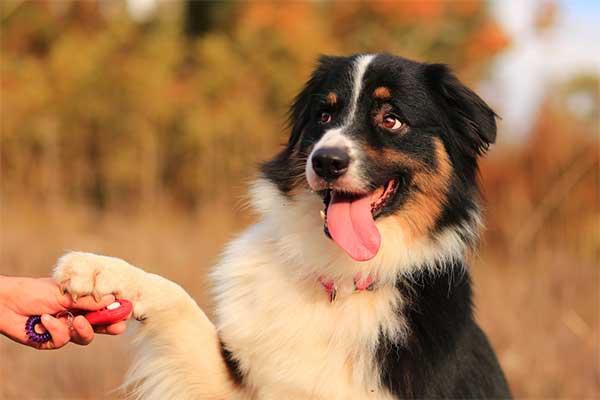
Marking Guide for Teaching Your Dog How To Bow
You can use this technique to teach your dog to ‘take a bow.’ Illustrated below is a step-by-step guide on how to achieve this.
Step 1: Keep some treats handy but out of sight. Don’t use pockets as your dog will get excited and expect a reward each time you reach into your pocket for your keys, wallet, phone, etc. Use the clicker, or say your marker word and feed your dog a treat immediately. After repeating this a few times, your dog will begin to associate the clicker or cue word with a treat.
Step 2: When your dog is about to go into a ‘bow’ (this usually happens when they stretch after waking up), keep your treat ready. As soon as your dog bows, mark the behavior and give them the treat.
Step 3: As your dog begins to bow of their own volition, add a verbal or hand command just before they do so. Follow this with the clicker or marker word and a treat.
Repeat ‘Step 3’ until your dog begins to respond to the verbal command consistently.
Useful Dog Tricks That Require Marker Training
- Sit Pretty
- Down
- Stand
- Fetch
- Responding to their Name
- Play Dead
Training and Shaping
Shaping is a training technique that uses marking to teach your dog behaviors and tricks that would not come to them naturally. For example, tricks such as fetching objects, finding things, or going to a designated place upon command are part of shaping training.
Shaping Can Be Used To Teach Your Dog Complex And Challenging Tricks That Are Useful, Practical, And Impressive.
The shaping process breaks down the tricks into smaller increments and provides your dog with rewards at every step until the full behavior is achieved.
Ready to try the shaping technique?
Shaping Your Dog Into Being Obedient
Teach your dog to obey your command to go to a specific place using these simple steps:
Step 1: Place your dog bed or mat at a designated spot where you want your dog to go, and get your treats and clicker ready.
Step 2: When your dog runs to sniff and investigate the area, immediately mark it with the clicker or verbal command, and reward your dog with a treat.
Step 3: Throw the food on the same spot to encourage your dog to return to it repeatedly.
Step 4: When your dog eventually begins to frequent the spot on its own, add a verbal cue to train them to respond to it.
Other Common Shaping Tricks To Teach Your Dog:
You can teach your dog a variety of impressive tricks with this method. Some of the most common and practical ones are:
- Come
- Heel
- Stay
- Roll Over
- Hug and Kiss
- Shake Hands
Here’s a list of silly tricks to teach your dog —kissing, spinning, ringing doorbells, or dancing—using the shaping method.
Hopefully, you’ve got a strong starting point that will help with your dilemma—How do I train my dog to do tricks?
Have fun experimenting with your dog, and at the next family reunion, let your dog show off all the new tricks he’s learned. After all, both you and your dog have put in a tremendous effort. Have some naysayers who don’t believe that you should teach a dog tricks?
Read on to learn how to handle them and why dog training is actually beneficial.
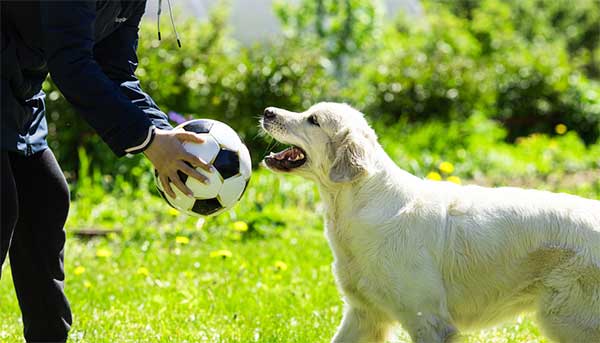
Is It Cruel To Teach A Dog Tricks?
Some claim that it is cruel to teach pets to do tricks for our amusement.
However, contrary to that belief, learning tricks is actually a lot of fun for your dog! They get a lot of love and affection in the process, and they also get to spend an immense amount of quality time with you.
Not to mention they get so many treats and get to see the delight on your face when they successfully perform a trick!
Here are more reasons why pets benefit from training.
Benefits Of Training Your Dog
Every dog can benefit from some instruction, no matter their age, size, breed, or temperament. Here’s why:
- It helps you understand your dog’s personality and specific needs, thus making you a better owner.
- Deepens your bond.
- Makes it easier to protect your dog when they’re off the leash.
- Allows your dog to be more sociable – other people will be more at ease if your dog is obedient, and your dog will have more positive experiences!
Properly Training Your Dog Is A Dog Owner’s Responsibility—It Ensures Their Well-being And Gives You Peace Of Mind.
- It is easier for people to dog-sit for you, which gives you the freedom to occasionally travel or go out without worrying about your dog.
- It keeps your dog’s mind sharp and alert – stimulation is essential for all living beings!
- Though you can always teach an old dog new tricks, it’s always best to start training them when they’re young.
Been working with your dog and not making much headway? Let’s explore what you should or should not do.
How Long Does It Take For A Dog To Master A Trick?
This is a difficult question to answer as it’s extremely subjective and depends on various things.
Here are some tips to efficiently train your dog and help them master their tricks faster:
- Do not shout or punish your dog. Negative reinforcement discourages them.
- Keep your sessions concise, positive, and fun. For example, do multiple 5-minute sessions a day, rather than one long session.
- Occasionally revise with your dog as they tend to forget things in new environments.
- Keep your tone and body language encouraging, positive, and cheery. Avoid getting frustrated.
- Keep your commands mono-syllabic, and use words that you don’t generally use often.
- Always reward your dog with treats for completing a trick.
- Shower your dog with pets and cuddles after every training session to boost their morale.
- Don’t hold back on compliments and affection.
Conclusion
Obedient, well-behaved dogs interact better with other people and animals, undergo less stress, and enjoy a better bond with you. They are generally better pets to have than untrained dogs as they experience fewer behavioral issues too.
Always Remember – Be Generous With The Treats, And Your Dog Will Be A Trick Master In No Time!
If you’ve ever asked someone, “what is the hardest trick to teach your dog?” the answers always differ as each dog is unique with an individual personality.
However, no matter what your dog is like, you can teach them all kinds of fun, interactive, and show-worthy tricks using the techniques mentioned above. And if you know another parent with a similar question to “How do I train my dog to do tricks?” please share this article with them!

